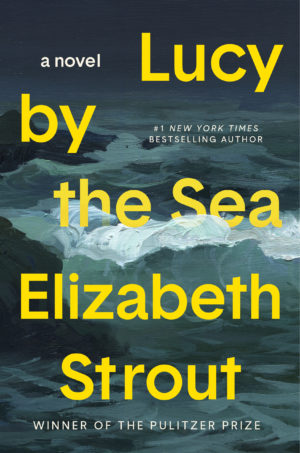Lucy by the Sea
by Elizabeth Strout
reviewed by Bailey Sincox
Elizabeth Strout paints with a fine brush on a small canvas. Like the works of Alice Munro, Strout’s novels are portraits of unremarkable, profoundly human lives. Her interest is in the local and the particular. From her debut Amy and Isabelle (1998) to her Pulitzer Prize-winner Olive Kitteridge (2008), Strout depicts a world of interconnected individuals, most of whom reside in small-town Maine.
In Lucy by the Sea, Strout continues the story of one of her most beloved characters against the backdrop of COVID-19. We first met Lucy in My Name is Lucy Barton (2016), in which a convalescent Lucy comes to terms with her impoverished childhood and an ambivalent relationship with her mother. We most recently saw her in Oh William! (2021), in which Lucy joins her ex-husband on an odyssey to meet his estranged half-sister. In this third Lucy novel, Strout brings her gift for the small scale to a global pandemic.
Once her ex-husband, William, persuades her to leave New York in March 2020, Lucy retreats with him to a house in Crosby, Maine, owned by Bob Burgess (of Strout’s 2013 The Burgess Boys). Lucy grows closer to William as they worry about their daughters Chrissy and Becka and their city from afar. Safe and sound—if slightly out of place—in Crosby, where the inhabitants have no great love for “out-of-towners,” Lucy and William come to terms with their place in the world and in each other’s lives.
Lucy by the Sea makes the pandemic personal. Collective grief for the pandemic’s toll brushes against more private tragedies: infidelity, miscarriage, impotence, widowhood. The novel is about the difficulty of feeling like a person during a global pandemic—indeed, the difficulty of feeling anything at all. A “dazed,” “fuzzy” Lucy looks away while William watches the evening news. Concerned that “my mind was not quite right,” she confesses: “I could not read. I could not concentrate.” While in earlier novels Lucy’s defining characteristic is her willingness to plumb her own depths, here Lucy loses faith in the value of self-knowledge through storytelling. “About my work I thought: I will never write another word again,” she says. As if crushed by the weight of a moment that promises to be historic, Lucy questions how—and whether—to relate the particular to the general.
Lucy by the Sea joins the growing ranks of COVID-19 novels. Like Louise Erdrich’s The Sentence (2021), Gary Shteyngart’s Our Country Friends (2021), and Ali Smith’s Companion Piece (2022), Lucy by the Sea is at heart a reflection on the artist’s role in times of plague. Yet Lucy has more in common with Virginia Woolf’s Mrs Dalloway (1925), itself a response to the 1918 flu as well as World War I, than with these contemporary works. Like Woolf, Strout turns memory and mourning into points of connection. In one scene, William meets Katherine, whom he encountered as a child when her father performed at his father’s funeral. The two marvel at their serendipitous reunion and mutual recognition. Katherine exclaims, “I cannot believe it was you that I saw in the backseat of that car so many years ago. I found you.” The novel’s crowning moment comes when a bridge is formed between Strout’s two most popular protagonists, Lucy Barton and Olive Kitteridge. Through Charlene Bibber, Lucy’s walking partner and Olive’s cleaner, Lucy hears of the feisty former math teacher Olive. It’s as if dispatches are being transmitted from one corner of the Strout universe to another.
In an especially resonant recollection, Lucy relates a film she watched as a child, “a blue screen with many white ping-pong balls bouncing around on it.” In her mind’s eye, she sees “the ping-pong balls bouncing around randomly and randomly hitting into one another,” thinking, “that is like people. My point is, if we are lucky we bounce into someone.” This is what Lucy by the Sea is really about: the fleeting miracle of bouncing into someone in our time—and in any time. This latest Lucy novel is remarkable for its attempt to record a still unfolding history and for its homelier, but no less remarkable, attempt to tether that moment to one woman’s consciousness.
Published on March 2, 2023

